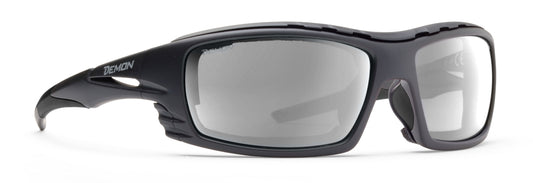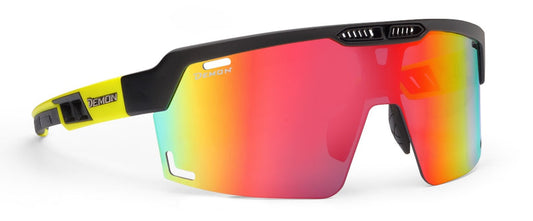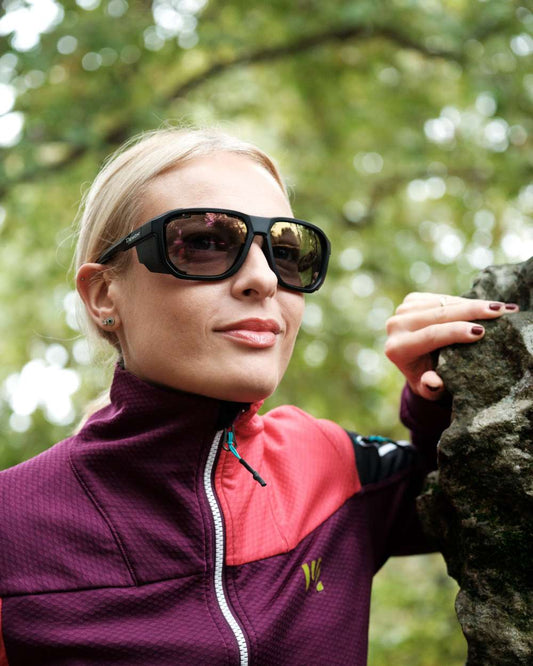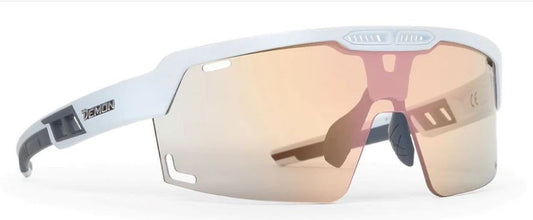-
SPEED VENT
Vendor:Mountain Glasses with High Contrast Mirrored LensRegular price €69,90Regular priceUnit price / per -
SPEED VENT
Vendor:Mountain Glasses with Photochromic Mirrored Lens DCHROM® Cat. 1-3Regular price €129,90Regular priceUnit price / per -
INFINITE OPTIC
Vendor:Mountain Glasses with Photochromic Lens DCHROM® Cat1-3Regular price €99,90Regular priceUnit price / per
Collection: Ski Glasses
SKI GLASSES
When selecting new ski goggles for the upcoming winter season, it's crucial to evaluate several key aspects that can influence your choice of eyewear. These factors include the material, shape, size, weight, atmospheric conditions of use, and compatibility with helmets or prescription glasses. By considering these elements, you can choose the perfect ski goggles to meet your needs.

At DEMON, we’ve developed an in-depth guide to assist you in selecting the right ski goggles by considering every aspect: structural design, lenses, suitability for various atmospheric conditions, dimensions, compatibility with helmets, compatibility with prescription lenses, and the specific discipline practiced.
Ski Goggles with Temples?
First, let's explore the structure of ski goggles. While we often think of the typical ski mask, it’s important to note that technical wrap-around sports glasses with temples can also be used for skiing.
It’s crucial to clarify that not all sunglasses are suitable for skiing. Using everyday sunglasses can lead to suboptimal performance compared to technical wrap-around ski goggles, and it also poses risks to your eye safety.
Why?
In mountainous and high-altitude regions, it’s essential to use lenses that provide optimal protection against harmful UV rays, preventing discomfort such as redness or tearing of the eyes by the end of the day. Additionally, lenses made from non-impact-resistant materials can be hazardous in the event of accidental impacts, potentially causing eye injuries from lens fragments.
Ski goggles with temples are part of the extensive family of mountain sports goggles. They are distinguished from regular sports goggles by their specialized accessories (such as a sweat sponge, removable side panels, and an adjustable elastic cord) and designs that ensure high performance for on-piste, off-piste, and ski mountaineering activities.
This type of ski goggles is favored by those who appreciate the convenience of wearing them under a helmet. They can also be used on warm days typical of late winter, providing sun protection and comfort during breaks in the cabin.
Furthermore, for ski mountaineers, goggles with temples protect the eyes from the sun, wind, and snow while climbing.

Types of Lenses
It’s crucial to outline the various types of lenses available for ski goggles, along with their strengths and weaknesses, to help you discern which type best suits your needs.
Polarized Photochromic Lenses (Category 2-4)
The Category 2-4 Polarized Photochromic lens represents the premium option for ski goggles with temples offered by DEMON. Like all lenses with photochromic treatment, this specialized lens begins with a basic smoke color and reacts to UV radiation or sunlight, initiating a reversible chemical reaction that darkens to Category 4 during maximum activity. When the light diminishes, the lenses gradually return to their initial transparent state.
The polarization of the lens focuses or disperses light rays, thereby attenuating UV-A and UV-B radiation and eliminating horizontal reflections. Ski goggles featuring this specialized lens can be utilized for all skiing disciplines (downhill skiing, ski mountaineering, and off-piste) and in varying atmospheric conditions, as they have a dynamic lens that adjusts to changes in light throughout the day on the slopes.

Photochromic Lenses (Category 2-4)
The Photochromic 2-4 lens is the counterpart to the Photochromic Polarized 2-4 lens. It retains the same UV protection characteristics and adjusts its darkness based on solar irradiation intensity, but without the polarizing effect.
Is It a Less Performing Lens?
Absolutely not! The true advantage of this lens, which is highly valued by ski mountaineers, is its ability to allow users to view GPS or heart rate monitor displays without needing to remove their ski goggles. The polarizing filter found in other lenses can create issues when reading LED screens, causing an annoying "rainbow effect" that hampers readability.
Due to its characteristics and performance, this lens is suitable for both downhill and off-piste skiing, but it is particularly well-suited for ski mountaineering.

Category 4 Lenses
Category 4 lenses are specialized lenses recommended for high-altitude mountain activities, such as mountaineering and ski mountaineering. They are particularly well-suited for glacier use, where intense snow reflection can be overwhelming. The monochromatic white of the ice can be especially bothersome without the appropriate lens. Additionally, Category 4 lenses are beneficial for individuals who are particularly sensitive to bright light.
These lenses are ideal for those seeking ski goggles for ski mountaineering or glacier skiing. However, they can also be used for downhill skiing by anyone who experiences discomfort in very bright conditions.

Polarized Lenses
The polarized lens, known as DPOL, offers protection from UV rays and more. This specialized lens can concentrate or disperse light rays, attenuating UV-A and UV-B radiation through a polarizing filter that eliminates horizontal reflections. Ski goggles with polarized lenses provide several advantages over standard smoke lenses, including improved contrast perception, sharper vision, preservation of natural colors, and the elimination of horizontal reflections.
Polarized lenses are suitable for individuals seeking ski goggles for downhill, off-piste, and glacier skiing. However, we do not recommend Category 3 polarized lenses for ski mountaineering. At higher altitudes, stronger filters such as the Photochromic 2-4 lens or Category 4 lens are necessary to adequately protect the eyes.

Smoke Mirrored Lenses
For those who prefer not to use photochromic, Category 4, or polarized lenses for their ski goggles but desire a lens similar to those found in everyday glasses—with the added benefits of impact resistance and maximum protection in bright light—smoke mirrored lenses are an excellent choice.
These lenses are crafted from durable, multi-layer polycarbonate that offers superior protection against harmful UV rays and can withstand accidental impacts, ensuring optimal safety for your eyes. This lens option caters to individuals seeking ski goggles that provide versatility while still delivering technical performance and eye protection.


Frame Materials
The frames of ski goggles are constructed using TR90, a special compound made from nylon and carbon fiber. DEMON utilizes TR90 for all its sports sunglasses frames and Vista Sport models. This hypoallergenic material is suitable for extreme conditions, including high and low temperatures, and can be used for prolonged periods without causing skin irritation.
A distinctive feature of TR90 is its exceptional elasticity and resistance to accidental impacts and mechanical stress (e.g., during lens changes). Additionally, it is 20% lighter than frames made from conventional materials, with typical frames weighing between 20 and 45 grams, depending on their thickness.
At DEMON, performance is the top priority. Choosing glasses with a TR90 frame ensures maximum performance, as the brand continuously seeks technical materials that guarantee comfort, safety, and aesthetics. The frames feature a soft, hypoallergenic Megol grip inside the temples, enhancing stability on the face even during intense vibrations or sudden movements. This feature also increases comfort, especially during prolonged use, such as a full day on the snow.
The high resistance of TR90 to extreme temperatures, without deformation or breakage, is essential for use in high-altitude mountain environments, where atmospheric and temperature conditions can vary greatly.

Ski Glasses for Prescription Lenses
Skiers who wear glasses have various solutions available to enhance their vision while skiing, including options with temples or adjustable elastic bands. All vision solutions are compatible with the helmets available on the market.
For both types of eyewear, optical clips are available that allow graduated prescription lenses to be inserted for vision correction.

Each model specifies the supported corrective powers, and it is important to identify which OUTDOOR model accommodates progressive prescription lenses. Below are the top optical models for skiing.

Another highly effective and high-performance system for ski goggles is the VISTA SPORT model. The uniqueness of this product lies in the inclusion of prescription lenses within the main lens, significantly enhancing the peripheral field of vision. Additionally, the lens is flattened through a special eyepiece support, allowing for the typical shape and wrap-around design of sports goggles, without the drawbacks associated with highly curved lenses, which can be costly to produce and may cause peripheral visual distortions.


HELMET COMPATIBILITY
Another crucial factor to consider is the compatibility of ski goggles with helmets. Each ski goggle in the collection is meticulously designed and crafted to ensure a perfect fit with every type of helmet. We view this as fundamental—a starting point in the design process, prioritizing safety above all, closely followed by comfort.























 English
English Deutsch
Deutsch Français
Français Español
Español Nederlands
Nederlands Português
Português Русский
Русский Polski
Polski Svenska
Svenska Norsk bokmål
Norsk bokmål Dansk
Dansk Suomi
Suomi Čeština
Čeština Magyar
Magyar Română
Română Slovenčina
Slovenčina Slovenščina
Slovenščina Hrvatski
Hrvatski Српски језик
Српски језик Български
Български Latviešu valoda
Latviešu valoda Lietuvių kalba
Lietuvių kalba Lëtzebuergesch
Lëtzebuergesch Türkçe
Türkçe 日本語
日本語 العربية
العربية 简体中文
简体中文 繁體中文
繁體中文 हिन्दी
हिन्दी ਪੰਜਾਬੀ
ਪੰਜਾਬੀ বাংলা
বাংলা